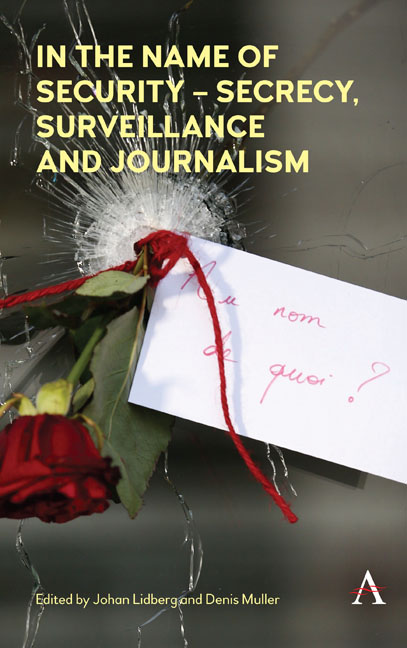Book contents
- Frontmatter
- Contents
- List of Tables
- Introduction
- Chapter 1 The Public Privacy Conundrum – Anonymity and the Law in an Era of Mass Surveillance
- Chapter 2 Undesirable Types – The Surveillance of Journalists
- Chapter 3 Surveillance and National Security ‘Hyper- Legislation’ – Calibrating Restraints on Rights with a Freedom of Expression Threshold
- Chapter 4 The Ethics of Reporting National Security Matters
- Chapter 5 When One Person's Noble Whistleblower Becomes Another's Poisonous Leaker
- Chapter 6 Who Watches the Watchmen? Access to Information, Accountability and Government Secrecy
- Chapter 7 Eyes and Ears in the Sky – Drones and Mass Surveillance
- Chapter 8 Looking over My Shoulder – Public Perceptions of Surveillance
- Chapter 9 Journalism and National Security in Three BISA Countries – Brazil, India and South Africa
- Chapter 10 Journalism and National Security in the European Union
- Chapter 11 The Security Reporter Today – Journalists and Journalism in an Age of Surveillance
- Conclusion: Journalism and the State of Exception
- Contributors
- Index
Chapter 2 - Undesirable Types – The Surveillance of Journalists
Published online by Cambridge University Press: 21 June 2018
- Frontmatter
- Contents
- List of Tables
- Introduction
- Chapter 1 The Public Privacy Conundrum – Anonymity and the Law in an Era of Mass Surveillance
- Chapter 2 Undesirable Types – The Surveillance of Journalists
- Chapter 3 Surveillance and National Security ‘Hyper- Legislation’ – Calibrating Restraints on Rights with a Freedom of Expression Threshold
- Chapter 4 The Ethics of Reporting National Security Matters
- Chapter 5 When One Person's Noble Whistleblower Becomes Another's Poisonous Leaker
- Chapter 6 Who Watches the Watchmen? Access to Information, Accountability and Government Secrecy
- Chapter 7 Eyes and Ears in the Sky – Drones and Mass Surveillance
- Chapter 8 Looking over My Shoulder – Public Perceptions of Surveillance
- Chapter 9 Journalism and National Security in Three BISA Countries – Brazil, India and South Africa
- Chapter 10 Journalism and National Security in the European Union
- Chapter 11 The Security Reporter Today – Journalists and Journalism in an Age of Surveillance
- Conclusion: Journalism and the State of Exception
- Contributors
- Index
Summary
Introduction
In 1954, an Australian Security Intelligence Organisation (ASIO) operative added another file to Rohan Rivett's voluminous dossier. Rivett was, at the time, the editor of Rupert Murdoch's beloved Adelaide News. The memo read:
Refer to Q report, 17 October 1952.
RIVETT is the editor in chief of the Adelaide News. He has covered a number of important world events, including the recent Indo- China Cease- fire negotiations in Geneva and the SEATO conference in Manila.
[Redacted title] which is owned by [redacted name] recently volunteered his opinion that RIVETT is ‘Red’, also that he does not mind engaging staff who have ‘similar pink tendencies as himself’.
It is noticeable that the ‘News’ does at times print articles and editorials of an extreme left- wing nature.
RIVETT came to South Australia from Victoria about five or six years ago. He is believed to have been twice married and there is a vague allegation that this first wife ‘was a Communist’.
In view of these allegations from several widely separated sources, it is requested that any available background information concerning RIVETT be forwarded to this office. (Rohan RIVETT, memo for Headquarters, ASIO from DV O'Leary, 9 December 1954)
The file note conveyed the common elements of many journalists’ security reports: the conspiratorial anxieties about communism and ‘pink’ ideas, morality, journalist identity and the power of the press. It also reveals a pattern and commitment to continual monitoring and a determination to silence the press regarded as ‘suspect’ – no matter how nebulous the evidence.
This chapter will examine the early surveillance of Australian journalists between 1916 and the late 1960s, integrating the experiences of Rivett, Godfrey Blunden, Sam White and little- known members of the Australian Journalists Association (AJA). The suspicion about journalists peaked at the height of the Cold War, when ASIO (the Australian Security Intelligence Organisation) ran what is termed ‘Spoiling Operations’ in the press. This involved editors and journalists running stories by ASIO based on security information leaked to newspaper editors, and later radio and television management.
- Type
- Chapter
- Information
- Publisher: Anthem PressPrint publication year: 2018



